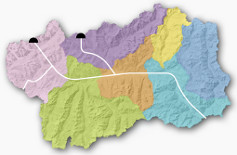The consular road to Gaul
Ancient Roman roads reached the great Alpine passes through the Aosta Valley
Pre-Roman roads in the Aosta Valley
In the pre-Roman period, there were already some primitive roads in the Aosta Valley. Since pre-historic times, these paths enabled trade and cultural relations through the Alpine passes. A pre-Roman road, called the Strada dei Salassi, still exists; it runs on the Aosta hillside at a higher level than the more recent Roman itinerary.
Roman expand the Empire: the consular road to Gaul
The consular road to Gaul was an indispensable infrastructure for the political and military expansion of the Roman empire. Thus, it was the first public work the Roman made in the Aosta Valley. Due to the geography of the region, the building of the consular road to Gaul in the Aosta Valley was a great work of engineering and construction.
The road crossed the lower Aosta Valley leading from Eporedia (Ivrea), up to Augusta Prætoria (Aosta), then split in two directions: to the Alpis Graia pass (Piccolo San Bernardo) and to the Alpis Pœnina pass (Gran San Bernardo). A great part of its itinerary is known, since archaeological ruins are still visible and there are ancient documents which mark places of rest for people and animals along the road.
The most monumental parts of the consular road are between Donnas and Bard and at Pierre Taillée (Avise), where the road cuts into the bare rock and is supported by cyclopean buildings. Other important archaeological ruins are the Roman bridge of Saint-Vincent and the Roman bridge of Châtillon, the ruins of the street in Montjovet and the sections of road and buildings in Arvier, Mecosse, Leverogne and Runaz.













